Welcome! If you are just now coming on board, please read the previous 3 blogs. That will set you up to continue this journey with me.
We were starving and Navine suggested we dine at a little restaurant nearby. Normally I take a picture of the menu, but I guess my mind was only on food. They brought this delicious lunch for us to enjoy.
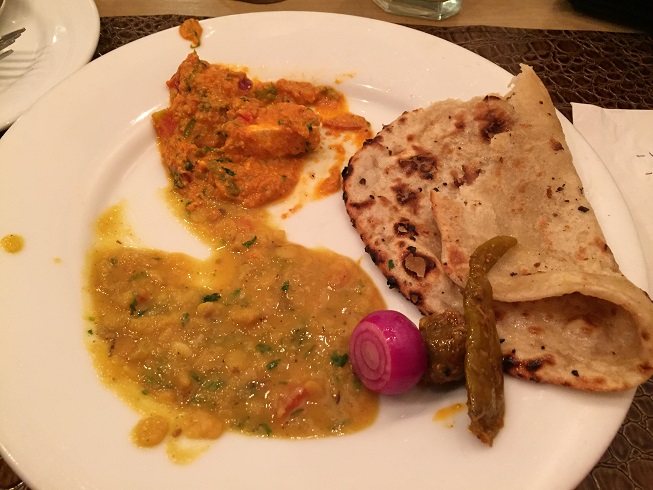
After lunch Jane decided to hang out with a snake charmer. I have to figure out how to put a video on my blog and I will share it separate. If you are my Facebook friend, you can find it there. It is worth seeing.
Back in the car we are driving through Delhi and Navine points out the Gandhi memorial site. Pilgrimage to many Indians, and foreigners who admire Mahatma Gandhi for his nonviolence approach to solve problems, the Gandhi Memorial can be found in the Raj Ghat area in Delhi. It is situated on the banks of the Yamuna River, which includes other burial sites of Indian rulers, like Nehru, Indira Gandhi and Rajiv Gandhi. It also includes the Gandhi museum, with his writings, belongings and photographs depicting the story of his life.
From the car we can see the park and immediately feel the welcoming silence. People picnicking on the grass, strolling down the lanes, walking towards the elevation in the park at a short distance. I wish we would have had time to stop and pay tribute, but we will save that for our next trip to Delhi.
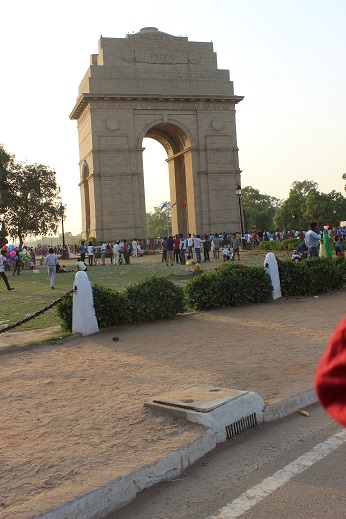
We head next for the India Gate. Yes I know you thought we might be in Paris, but no.
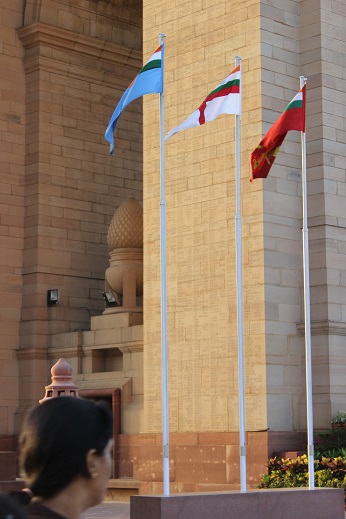
The India Gate, (originally called the All India War Memorial), is a war memorial located astride the Rajpath, on the eastern edge of the ‘ceremonial axis’ of New Delhi, formerly called Kingsway. India gate is a memorial to 82,000 soldiers of the undivided British Indian Army who died in the period 1914–21 in the First World War, in France, Flanders, Mesopotamia, Persia, East Africa, Gallipoli and elsewhere in the Near and the Far East, and the Third Anglo-Afghan War. 13,300 servicemen’s names, including some soldiers and officers from the United Kingdom, are inscribed on the gate.
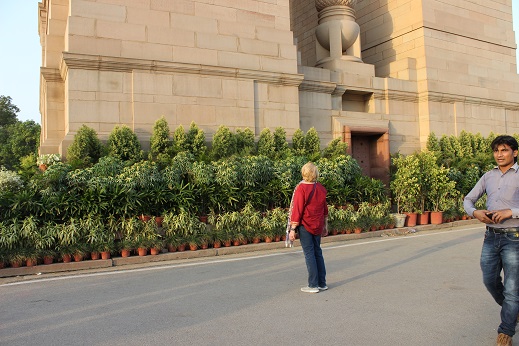
The India Gate, even though a war memorial, evokes the architectural style of the triumphal arch like the Arch of Constantine, outside the Colosseum in Rome, and is often compared to the Arc de Triomphe in Paris, and the Gateway of India in Mumbai. It was designed by Sir Edwin Lutyens.
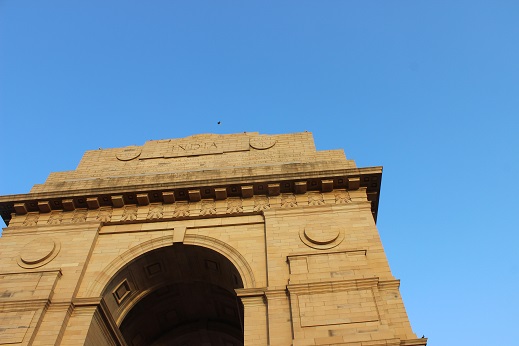
In 1971, following the Bangladesh Liberation war, a small simple structure, consisting of a black marble plinth, with reversed rifle, capped by war helmet, bounded by four eternal flames, was built beneath the soaring Memorial Archway. This structure, called Amar Jawan Jyoti, or the Flame of the Immortal Soldier, since 1971 has served as India’s Tomb of the Unknown Soldier.
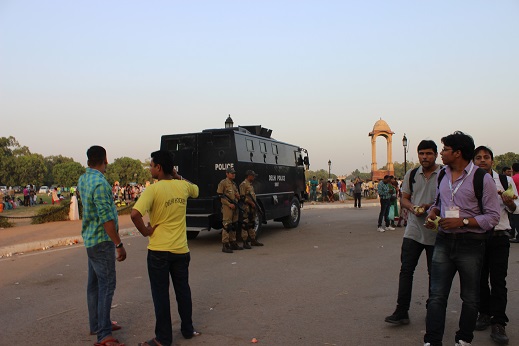
As we were headed to look at the canopy, we saw this cool police truck. The park surrounding the memorial was filled with visitors enjoying a day out.
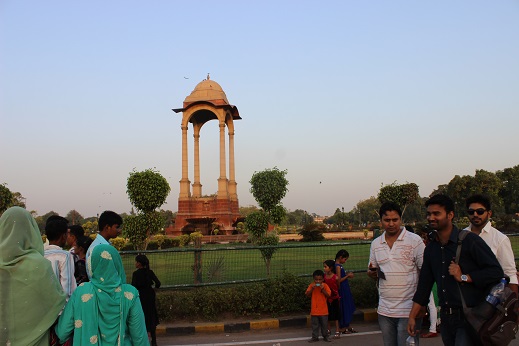
About 150 meters East of the India Gate war memorial, at a junction of six roads, is a 73-foot cupola, inspired by a sixth-century pavilion from Mahabalipuram (remember I visited there on my way back from Chennai to Bangalore last trip-see: India 2 Blog). Lutyens used four Delhi Order columns to support the domed canopy and its chhajja. Under the canopy on a pedestal with the Royal Coat of Arms and the inscription GEORGE V R I (‘Rex Imperator’, or ‘King Emperor’) there was a fifty-foot-tall marble statue by Charles Sergeant Jagger of King George V, in his coronation robes, Imperial State Crown, British globus cruciger and sceptre, which sometime during or after the statue’s removal broke off. Since the shifting of the old statue in the 1960s to Coronation Park to join other British Raj-era statues, it was often suggested that a statue of Mahatma Gandhi be placed under the cupola, where the king’s statue once stood. The suggestion was even discussed in the Indian Parliament. In 1981, the Government in response to a question in parliament confirmed that it was considering the installation of Mahatma K Gandhi statue under the empty canopy, but nothing came of it.
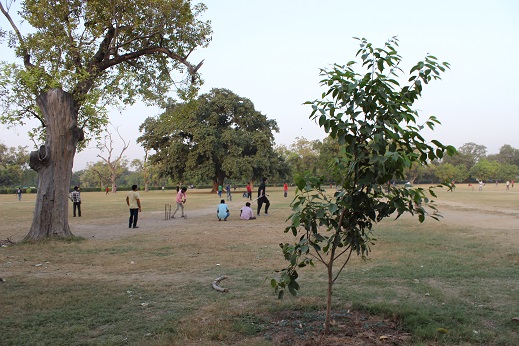
As we headed back to our car, we noticed some guys playing cricket and stopped to watch.

I promised the White House. Well almost. This is where the President of India lives. The gates were beautiful and there were lots of policeman around. It was getting dark by now so the picture isn’t the best. The Rashtrapati Bhavan (“Presidential Residence”) is the official home of the President of India, located in New Delhi, Delhi, India. It may refer to only the mansion (the 340-room main building) that has the President’s official residence, halls, guest rooms and offices; it may also refer to the entire 130 hectare (320 acre) President Estate that additionally includes huge presidential gardens (Mughal Gardens), large open spaces, residences of bodyguards and staff, stables, other offices and utilities within its perimeter walls. The main palace building was formerly known as Viceroy’s House. In terms of area, was the largest residence of a Head of State in the world. Now the largest presidential house is in Turkey.
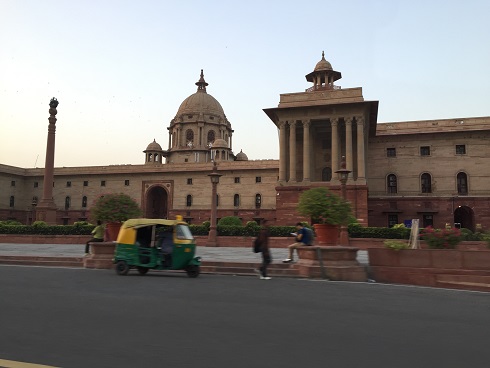
This building and one identical like it (across the street) were also part of the complex. It has been a long day and I couldn’t think of anything I wanted more than a massage.
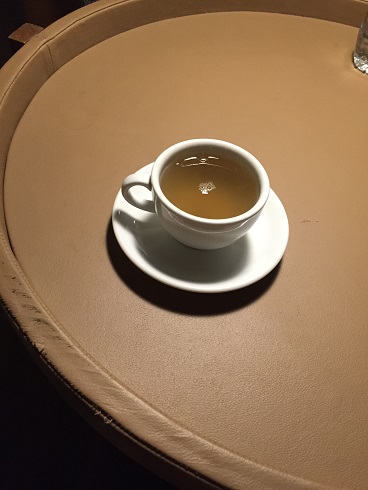
Once back at the hotel, as I awaited by massage, a lovely cup of chamomile tea was set in front of me. A great day, in a great city. Time to digest and relax.
Tomorrow is Day 2 in Delhi, with a lot on the agenda. Keep reading and sharing. I love your feedback…
